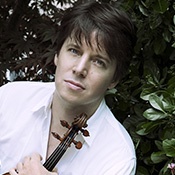Gustavo Dudamel was back in town on Sunday to conduct the LA Phil in a program including the Brahms Violin Concerto in D major, Op. 77 with Joshua Bell as soloist and two early tone poems by Richard Strauss, Don Juan and Till Eulenspiegel’s Merry Pranks.
Dudamel opened the concert with Towards Osiris by the German composer Matthias Pintscher. The piece is based on the ancient Egyptian god Osiris and his rivalry with his brother Set in which Set tears apart Osiris’ body and scatters the pieces up and down the Nile, after which Osiris’ wife finds and sews them back together to reanimate him. The composition attempts to present little pieces of sound separately and then recombine them in different ways. Like much contemporary music, it is sonically intriguing.
Compositions like Towards Osiris are very interesting to hear live, in part, because one can watch all the individual instruments contributing to the whole sound and, in part, because of the actual sound itself, which is better heard live especially in a hall like Walt Disney Concert Hall. But pieces like this also raise the question of what music is.
Some definitions of music refer to “vocal or instrumental sounds (or both) combined in such a way as to produce beauty of form, harmony and expression of emotion” or “a sound perceived as pleasingly harmonious.” Other definitions refer to “an art of sound in time that expresses ideas and emotions in significant forms through the elements of rhythm, melody, harmony and color” or “the tones or sounds employed, occurring in single line (melody) or multiple lines (harmony), and sounded or to be sounded by one or more voices or instruments, or both.”
Towards Osiris conforms much more to the second two definitions than to the first. Of course, what is beautiful or “pleasingly harmonious” is probably in the ears of the beholder. However interesting Towards Osiris is, how many people are going to go home and put it in the CD player or on the turntable? Not only that — and this reveals my bias — but I like to walk away from hearing a piece of music being able to hum it. Maybe I’m just a product of my pop music history, or maybe one needs to listen to something many times to be able to hum it. Regardless, there is no question that Towards Osiris does express “ideas and emotions in significant forms through the elements of rhythm, melody, harmony and color,” and in that regard it is definitely musical.
Either way, I’m glad that Dudamel programs contemporary music such as Towards Osiris, and I appreciate the opportunity to hear it performed live.
The rest of the program conformed to the first two definitions of music. The Brahms violin concerto is arguably the greatest ever written, and it is full of “pleasingly harmonious” sounds. It expresses intense emotion as many of Brahms’ works do. The two Strauss poems are also intensely musical according to all the definitions listed above, even if there are occasional moments of dissonance.
With Bell’s new responsibilities as conductor of the Academy of St. Martin in the Fields, his grueling schedule and his stature as a rock star in the classical world, I wasn’t expecting as much from his playing as I would have when he was younger. But I was pleasantly surprised. Still looking like a kid (he’s only 48, though it seems like he’s been around forever), he dug in to the Brahms and gave the audience a rousing and animated performance in the first and third movements, and a wonderfully sensitive one in the slow movement. Bell, in a long line of violin virtuosi, played his own cadenza, which, for this reviewer, was not as satisfying as the original by Joseph Joachim, to whom Brahms dedicated the concerto. Having said that, it is always interesting to hear what a violinist of Bell’s caliber does with a cadenza. It certainly displayed his technical prowess and his musical understanding.
Dudamel provided a very sensitive accompaniment, as he usually does, perhaps in this instance in part aided by the fact that he, too, is a violinist. And Marion Arthur Kuszyk gave us a very moving oboe solo in the slow movement.
Don Juan was composed only 10 years after Brahms composed his violin concerto, but what a difference 10 years makes. Strauss’ musical expression and orchestration expanded on Brahms’ decidedly classical form and structure. Both Strauss tone poems are orchestral showcases, as are all of the Strauss tone poems, and the LA Phil shone in every respect, especially the horns, an instrument which Strauss himself played. Andrew Bain and Amy Jo Rhine nailed the difficult three-octave horn parts in Till Eulenspiegel, and Andrew Lowy showed his chops on the E flat clarinet.
—Henry Schlinger, Culture Spot LA
For information on upcoming concerts, visit www.laphil.com.






